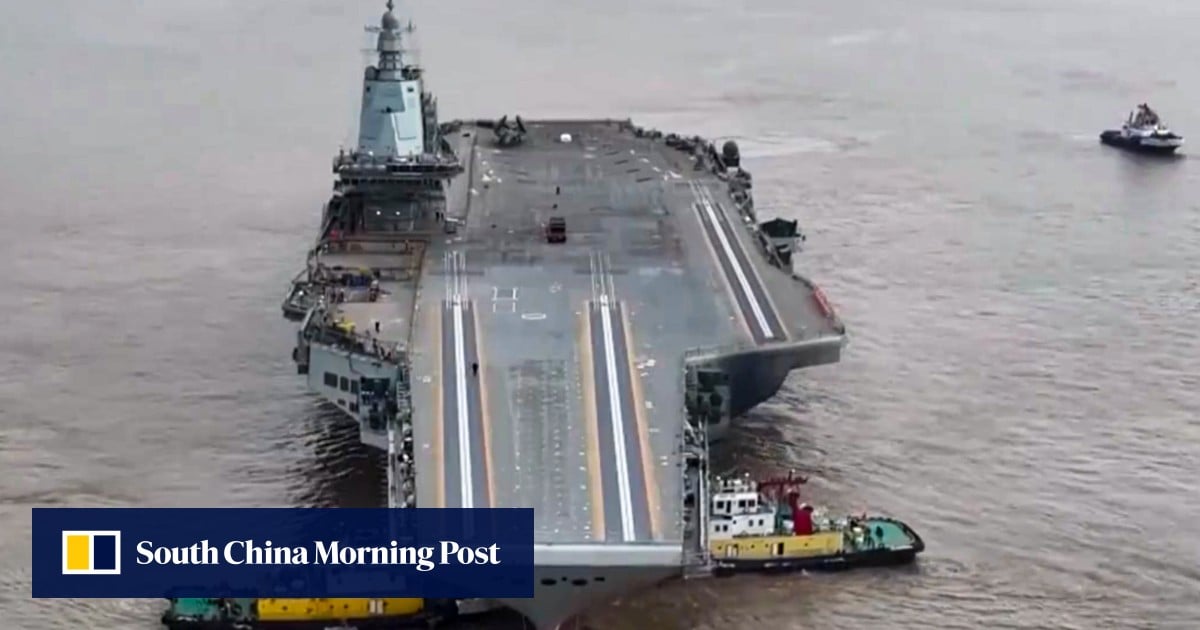China unveiled its aircraft carrier, the Fujian, equipped with state of the art electromagnetic catapults, making an advancements in its naval capabilities. The unveiling was featured in the state broadcaster’s nightly news program, addressing the vessel’s importance in President Xi Jinping’s call for national rejuvenation.

Also Read: SpaceX’s Starlink Launches Cell Phone Service Satellites
The Fujian, China’s third aircraft carrier, is a Type 003 carrier, launched in June 2022, and is the first in the country to feature electromagnetic catapults for launching planes from its deck.
The Fujian’s electromagnetic catapults represent cutting-edge technology, providing several advantages over traditional steam catapults.
The electromagnetic catapult system is powered by electromagnets, enabling more launches of aircraft with increased fuel and munitions capacity.
This technology is only employed by the United States, making China one of the few nations with such advanced carrier capabilities.
China’s first two aircraft carriers, the Liaoning and the Shandong, utilize ski-jump take-off ramps for launching planes.
The Fujian’s electromagnetic catapults shows carrier launch capabilities. The shift to electromagnetic catapults allows for operational flexibility, increased sortie-generation rates, and improved overall efficiency compared to traditional methods.
The unveiling of the Fujian in a news program suggests China’s confidence in the carrier’s development and underlines its commitment to building a blue-water navy capable of operating in the open ocean. China aims to have at least six aircraft carrier battle groups by 2035.
The appearance of the Fujian in the state media report coincided with President Xi Jinping’s New Year’s call for national rejuvenation, addressing the importance of the military’s role in unifying mainland China and Taiwan.
Also Read: North Korea to Launch 3 More Spy Satellites in 2024
The Fujian has yet to undergo sea trials to test its systems and components fully. Recent footage showed the carrier in a dry dock at Shanghai’s Jiangnan shipyard, where it was initially built.
Reports suggest that the carrier has undergone mooring tests according to plan, and observers speculate that it might undergo improvements or maintenance during its stay in the dry dock.
Analysts, including former PLA instructor Song Zhongping, suggest that the carrier might undergo improvements, hull cleaning, and degaussing during its time in dry dock.
Degaussing is crucial for neutralizing the ship’s magnetic field, reducing vulnerability to magnetic-sensitive weapons and sensors.
While Song did not speculate on the duration of the Fujian’s stay in the shipyard. Captain Yin Hongxin, a Chinese navy officer, reported progress in mooring tests during the news segment.
Mooring tests involve assessing the vessel’s main propulsion machinery while it is anchored. These tests are steps in ensuring the carrier’s readiness for sea trials and eventual operational deployment. Yin expressed the PLAN’s goal to establish combat capabilities in 2024.
The CCTV report provided glimpses of scaffolding on the Fujian’s command center island structure and an aircraft mock-up on the flight deck.
The presence of a mock-up suggests that mooring trials also involved testing aircraft scheduling, loading, unloading, and positioning on the flight deck.
While the exact type of aircraft in the mock-up remains unclear, speculations range from the J-15 fighter jet to a next-generation stealth fighter known as the J-35.
The composition of the Fujian’s air wing is a subject of interest, with possibilities including a catapult-variant of the J-15, the J-35, the KJ-600 carrier-based airborne early warning and control aircraft, and various helicopters.
Also Read: U.S Military Launches X-37B Robot Space Plane for 7th Secretive Mission
The unveiling of the Fujian’s electromagnetic catapults, with progress in mooring tests, suggests that sea trials are on the horizon.
Experts anticipate multiple sea trials in 2024, addressing the PLAN’s commitment to achieving operational capability as soon as possible.
The maiden voyage of the Fujian is eagerly awaited, and once in service, it will join the ranks of a select few navies globally with catapult-assisted takeoff but arrested recovery (CATOBAR) carriers.
The U.S. and French Navies are the only others operating CATOBAR carriers, making China’s entry into this group a notable development.
As the PLAN expands its fleet and operational reach, it enhances China’s ability to project power beyond its shores. The Fujian’s deployment in the Indian Ocean, as suggested by naval experts.
The Fujian’s catapult technology places China in a select group alongside the U.S. and France. The U.S. Navy’s use of Electromagnetic Aircraft Launch System (EMALS) on the Gerald R. Ford-class carriers has set a benchmark for modern carrier operations.
China’s successful implementation of similar technology shows its growing capabilities to challenge established naval norms.
President Xi Jinping’s call for military modernization by 2027 with efforts to achieve a rejuvenated and technologically advanced military force.
The Fujian’s role in this vision its immediate naval capabilities, symbolizing China’s ascent as a maritime power.
The carrier’s deployment would also be strategic interests, including operations around Taiwan, an issue in Sino-Taiwanese relations.
Also Read: China’s Ocean Drilling Ship Mengxiang to be First to Reach Earth’s Mantle





















